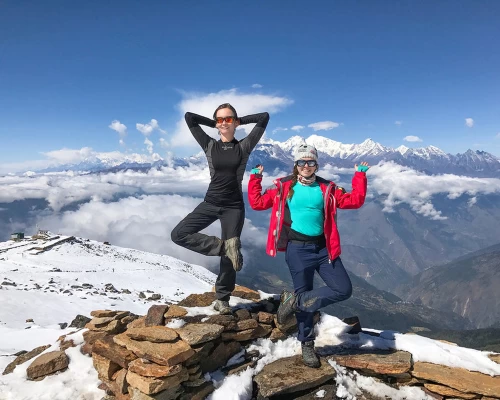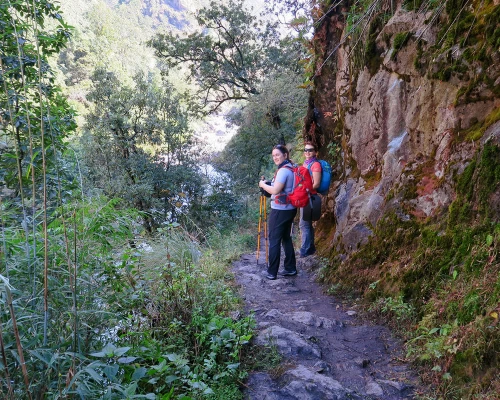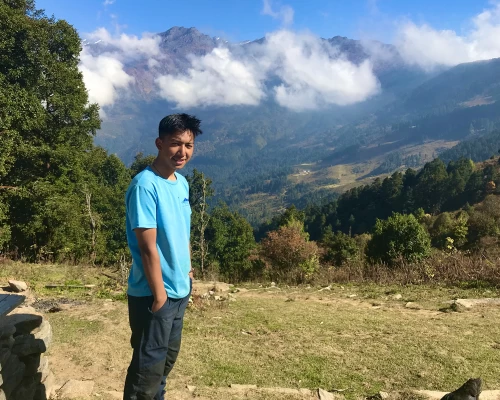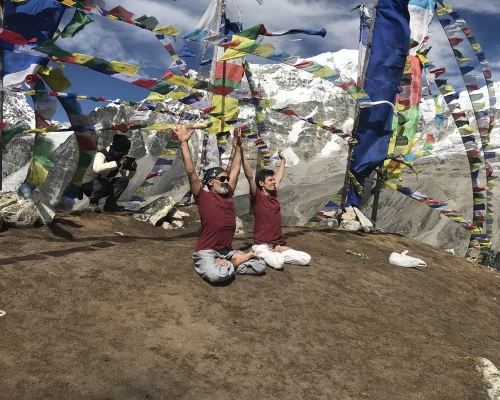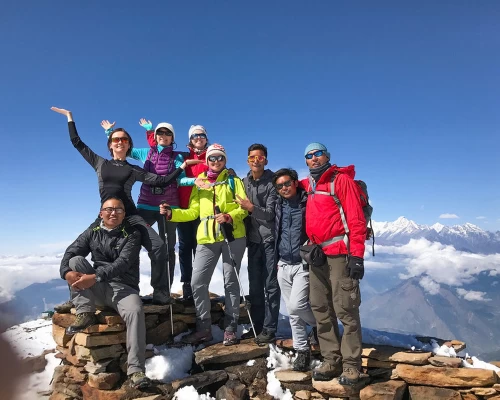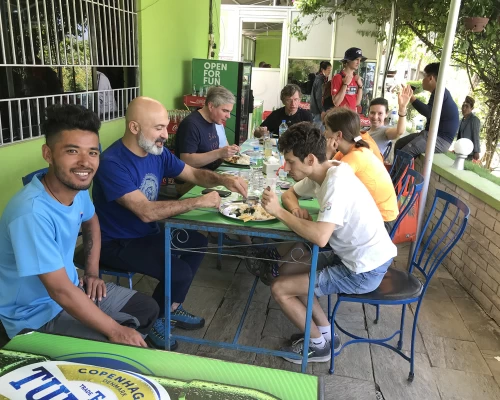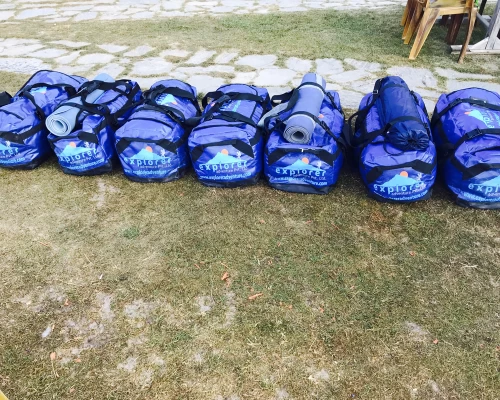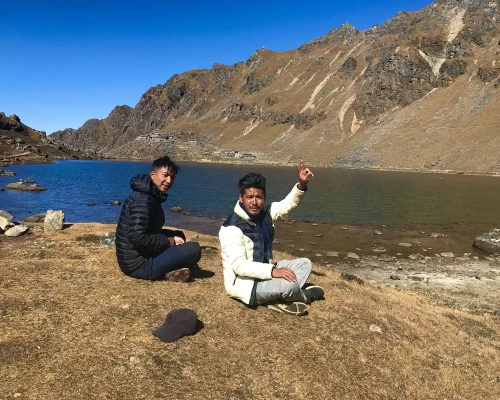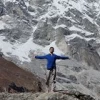Trek Grade

Langtang Valley Gosainkunda trekking is categorized as a moderate-level trek. The distance to be covered is about 177 km, which requires about 4 to 6 hours of daily hiking while covering about 10 to 15 km per day. Despite the trek having no technical climbing difficulties, you have to traverse through terrains with steep ascents and descents, glacial moraines, and narrow paths that add a certain level of difficulty to the trek.
Hike from Kyanjin Gompa to Kyanjin Ri with an altitude gain of more than 750 m is one of the challenging parts of the trek that elevates you to an altitude of 4773 m. However, once you reach the top, the 360 views of the Himalayan range will enchant you
Accommodations And Foods

Accommodations
The 15-day Langtang Valley Gosainkunda Trek covers all the accommodations, including staying in Kathmandu for three nights and another 11 nights in the Langtang region. For three nights in Kathmandu, you will be provided with a well-equipped room on a sharing basis in a standard hotel.
Likewise, during your trek, we will arrange your accommodations in tea houses or lodges. You will be provided with a room on a twin-sharing basis. The two beds will be adjacent to each other. Some teahouses may have attached bathrooms in the Western style, while some may have traditional squat bathrooms that will need to be shared in the same vicinity.
Moreover, teahouses and lodges have communal dinners where you can interact with other fellow trekkers and expand your socializing skills.
Foods and Beverages
Langtang Valley Gosainkunda Trek is one of the mainstream trekking in Nepal, usually flocked by trekkers worldwide both in peak and off seasons. So, teahouses and lodge owners have expanded their menus from regional and traditional Nepalese foods to Indian, Tibetan, and other foreign cuisines.
You can expect Oatmeal, Corn Flakes, French toast with Jam, Butter, Cheese, Honey, Tibetan bread or Chapati, Local Tsampa porridge, Eggs, Pancakes, Muesli Breads, fruits, Vegetables, Paratha, Sel roti, Puri tarkari, Pancakes, etc for breakfast.
Similarly, you can expect Dhal Bhat Tarkari, Tibetan Bread, Various Soups, Sherpa Stew, Steaks, Sandwiches, Momo, Macaroni, Tenduk, Spaghetti, Thukpa, Pasta, Potatoes, Vegetables, Thakali khana set, Rildok, Gundruk Dhindo etc for lunch and dinner.
Regarding beverages, you have diverse options to choose from. You have a variety of beverage alternatives to pick from. Seasonal fruits, freshly squeezed juices, hot drinks such as tea and coffee, hot chocolates, and even limited sodas such as Coke, Fanta, and Sprite are available. Teahouses also have many options for hard drinks, from branded wine to regional drinks like chyang, raksi, thongba, etc.
However, the cost of 3 meals and snacks (breakfast, lunch, and dinner) is not included in the package. You will have to pay for them from your own pockets. It will cost you approximately $20 to $30 per day. Moreover, alcohol causes dehydration and aggravates AMS. It will also affect the acclimatization process at a higher altitude. So, we strongly suggest you skip hard drinks during the trek.
Guides And Porters

Many people believe trekking is about going out of their comfort zone to test their resilience and push their limits. This statement is true as you are going to hike long hours to uncover the rugged, steep terrains and still proceed with the trek despite exhaustion. However, you need to think about your safety and comfort while going on these long treks.
You are not habituated to carrying 9 kg weights on your back and navigating the trails with a map in your hand. So hiring guides and porters to simplify the already difficult Langtang Valley Gosainkunda trek is totally okay. Our guides will help you navigate the trails while providing you with proper knowledge about the culture, myths, traditions, and history of the region.
Likewise, they are well-trained in basic first aid and fast to respond in the event of altitude sickness. So, if you encounter any accidents or mishaps, they will take you to a nearby medical center or assist you in the evacuation process. Our guides are well-versed in eco-trekking and responsible tourism. They are committed to keeping the environment on the trekking routes safe and pristine.
Furthermore, our porters will assist you in carrying big loads of baggage and equipment, allowing you to experience the beauty of Langtang with ease. We will make you available one porter for two trekkers with a maximum carrying weight of 15 to 25 kg. Rest assured, we do not hire porters under the age of 16 and above the age of 50. Even though the cost of guides and porters is included in the package, tipping them is exclusive. There is no any set amount for tipping guides and porters, but tipping them is usually expected if the services they provide are satisfactory.
Packing List

It can be somewhat confusing while packing things for the trek. The packing list for Langtang Valley Gosainkunda Trek does not alter much with the seasons because you must be prepared for any unanticipated changes in weather and other events. However, you should not miss out on the essentials and pack the unnecessary things, making the luggage overload. You can take this packing list as a reference if you are afraid to overlook important stuff.
Clothes
- Convertible Hiking shorts or pants
- Long-sleeved shirt and T-shirt
- Hooded rain jacket
- Fleece jacket
- Lightweight cotton pants
- Extra pair of underwear and socks
- Down jacket
- Sweater
- Waterproof jacket and pants
- Lightweight gloves
- Heavyweight winter gloves
- Sun hat or scarf
- Buff
- Winter hat or insulating hat or Wide-brimmed hat or beanie
Shoes
- Hiking boots
- Lightweight sandals to wear in teahouses
Equipment
- Trekking poles
- Backpack or daypack
- Sleeping bag (four seasonal sleeping bags recommended)
- Binoculars, camera
- Headlamp with extra pair of batteries
- Power bank, solar charger
- Universal charging cord
- Reusable water bottles
- Thermos flask
- Card and board games
- Magazine, journal, pens
Toiletries And Personal Hygiene
- Toothpaste, toothbrush, facewash, Hand sanitizer
- Sunscreen, body lotion, and lip balm
- Soap, shampoo and conditioner
- Quick dry towels, toilet paper, Wet wipes, and face towel
- Deodorants
- Foot powder
- Vaginal wash
- Personal medication (if any)
- Water purification solution or tablets
- Small first aid kit with all basic medications
Travel Insurance

It is very essential to be insured with a travel insurance policy while trekking to the mountains. Despite the fact that you do not want to think about any accidents and mishaps, you will be hiking all day on those rugged and steep paths. So, there is no surety that any unforeseeable circumstances won’t occur.
Hence, to mitigate the risk and share the financial burden, you have to take the policy that will cover all your medical expenses, hospital bills, air ambulance, and evacuation costs. Most travel insurance does not include the cancellation expense. This will help you to cover the pre-paid expenses like accommodations, flight costs, and visas in case you have to cancel the trek due to some personal or other reasons. Therefore, we encourage you to take the policy that will cover even cancellation expenses.
Altitude sickness and other safety measures:
When the altitude rises, the air in the atmosphere gets less dense, and the percentage of oxygen in the air decreases. While trekking, our body needs to adapt to the lower oxygen level, but when the body is unable to adapt to the low partial pressure of oxygen at a high altitude, a pathological condition known as altitude sickness occurs.
The common symptoms of acute mountain sickness or altitude sickness are headache, nausea, vomiting, lack of appetite, insomnia, shortness of breath, fatigue, and drowsiness.
Moreover, it is normal to fall prey to altitude sickness as you ascend above 3000 m, so you dont have to worry about others' opinions or feel burdensome if you are going to hinder others' journey. Nothing is more important than health. So, if you experience these symptoms, you must not ignore them and continue your journey. You must notify the guides of your symptoms so that they can provide you with medical treatment as soon as possible.
Furthermore, to avoid altitude sickness, it is very important to ascend slowly by taking breaks. You should also acclimatize properly and intake about 3 to 4 liters of water daily to reduce dehydration. It is better if you intake more soluble goods with proper balanced meals.
Preparation mentally and physically

Trekking can be physically and mentally demanding. Even though the Langtang Valley Gosainkunda trek requires a basic level of physical fitness, it is never too late to start a good habit. So you can try to enhance your physical strength by some regular exercises like swimming, jumping, walking, and even hiking. You can try some cardiovascular exercises to increase your stamina.
Moreover, even old people want to embark on this trek because of their religious belief in Gosainkunda, so they can try to consult with a medical doctor or physician to do some physical strengthening exercises.
At the same time, it is very essential to prepare yourself mentally while coming on this trek. It is not everyone's comfort zone to walk for long durations. So, you need to be mentally prepared for hiking and the exhaustion of trekking. Moreover, you cannot expect some top-notch amenities in the rural areas. You won't find Uber or a cab in case you dont feel like walking.
You need to make sure that you are okay with adapting to any unusual circumstances out of your comfort zone. Lastly, it is best not to have unrealistic expectations regarding trekking since if those expectations are not met during the journey, you will not be able to have actual fun during the trek.
Langtang Valley Gosainkunda Trekking Cost

There are various factors like itinerary, accommodations, and meals that can vary the cost of the trekking package. If you subscribe to our 15-day Langtang Valley Gosainkunda trekking package, then it will cost you around US $770 per person. The total cost includes accommodation and breakfast in Kathmandu, transportation, permits, porter and guides, and all government taxes and official expenses.
However, flight costs, meals and drinks, and other additional costs like hot showers, Wi-Fi, and re-charging of your electronic devices like camera and mobile are exclusive of the above price. In case you want to have variations in the route or add any amenities to the package, we are always available to upgrade or customize the package for you.
For additional information on the costs associated with the Langtang Gosaikunda Trek, please refer to the Langtang Gosaikunda Trek Cost article.
Permits
If you are new to trekking in Nepal, you may wonder what permits are. Permits are more like a ticket to adventure. You need certain documents or papers before you enter a specific area in Nepal while trekking. Hence, permits are a crucial element to consider before embarking on the Langtang Valley Gosainkunda trek.
For the Langtang adventure, you are required to obtain two permits. One is the Langtang National Park permit, while the other is the TIMS card.
For any of the trekking routes in the Langtang region, you have to walk through the trails of Langtang National Park. So, it becomes mandatory to obtain a Langtang National Park Permit.
Cost of Langtang National Park Permit
For foreign nationals other than SAARC countries= NRS 3000 per person per entry( around US $30)
For SAARC nationals= NRS 1500 per person per entry ( around US $15)
For Nepalese citizens = NRS 100 per person per entry
Likewise, children under the age of 10 are allowed to have free access to the region, but proof like passports is mandatory. All these costs are exclusive of VAT. Moreover, you can obtain this permit in Kathmandu at the Nepal Tourism Board. if you are running out of time, then you can get this permit at the trailhead in Dhunche.
The Trekking Information Management System(TIMS) is a record of the trekkers for safety and security and to control the illegal trekking operations in Nepal. You will find three types of TIMS cards in Nepal: blue, and pink.
If you are a group trekker under a government-registered trekking agency like us, then you will be given blue cards. Similarly, if you are a national of any SAARC country, then you will be provided with a pink TIMS card.
Cost of TIMS card
For any foreign nationals other than SAARC countries(group trekkers)= NRS 1000 per person, around $10
For SAARC nationals( Group Trekkers)= NRS 300 per person, around $3
The TIMS card can be obtained either from Kathmandu or Pokhara, wherever you feel easy to have access. If you think getting these permit cards is a tremendous headache, let us assure you that these permit cards are included in our package, so you won't have to stroll around here and there to obtain them.
Best Season

Langtang Valley is beautiful any time of the year, so exploring the Langtang Valley and Gosainkunda is open all year round. However, spring and autumn seasons are considered more favorable than other seasons to entrain on this thrilling journey.
The months of March to May bring the liveliness of nature to the entire Langtang Valley. When the rhododendrons bloom in the lush forest, it spreads the fragrance of spring. Moreover, the pasturelands and meadows get their greenery back, attracting yaks for grazing. The petals of wildflowers scattered on the trails make you feel like you are walking on the red carpet.
Likewise, in the months of September and November, the Langtang region changes its face to the reddish color of fall. The festive environment provides you with an opportunity to learn more about the culture, traditions, and people inhabiting the region.
Furthermore, both seasons have stable weather with longer days, offering you more time to immerse yourself in the beauty of lakes and the Himalayas. The sky is clear with fewer clouds allowing you to have a better sight of the snow-clad mountain peaks.



